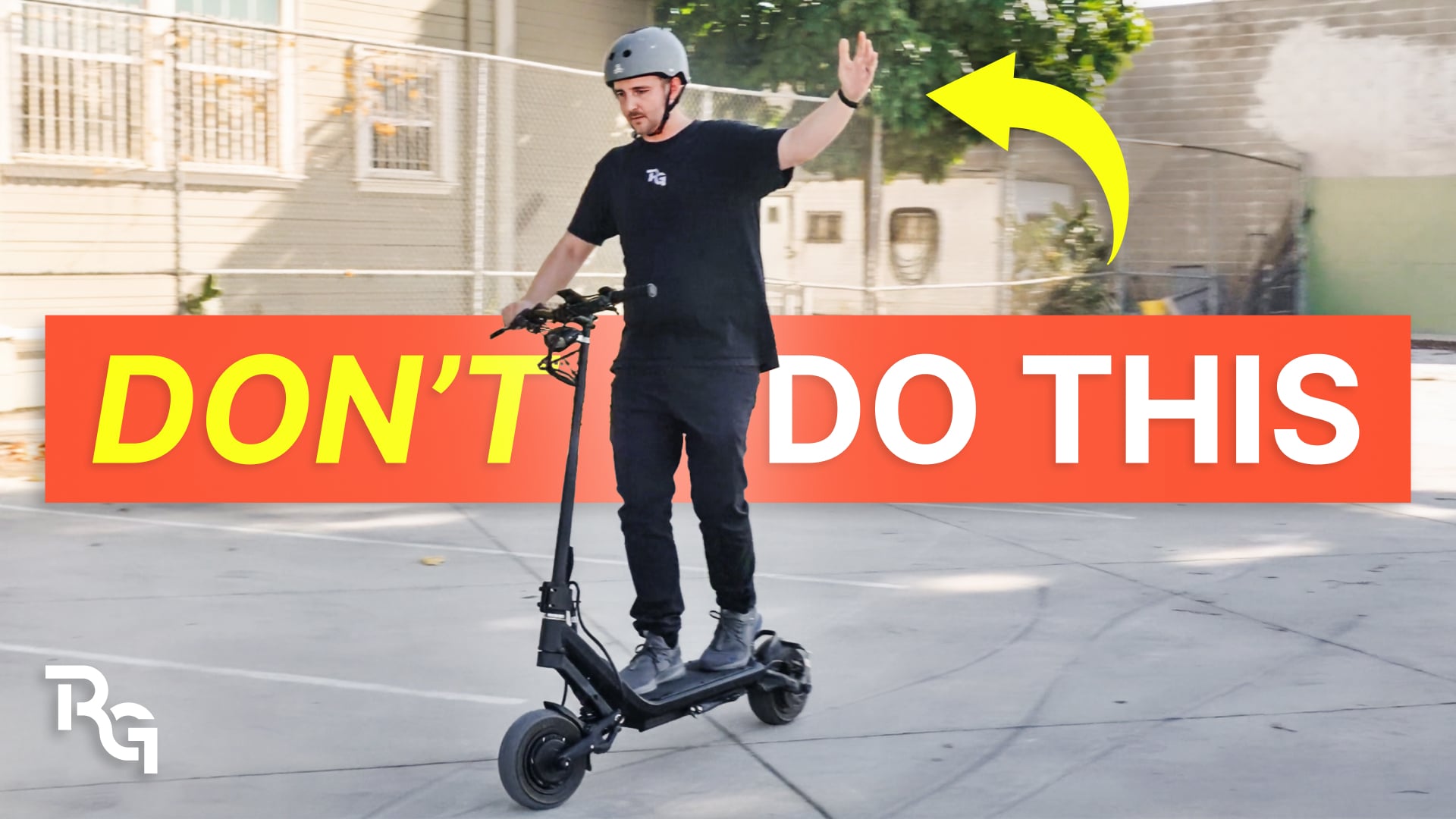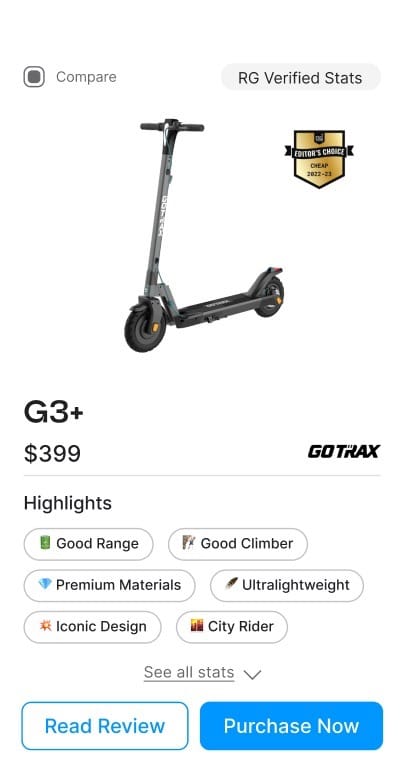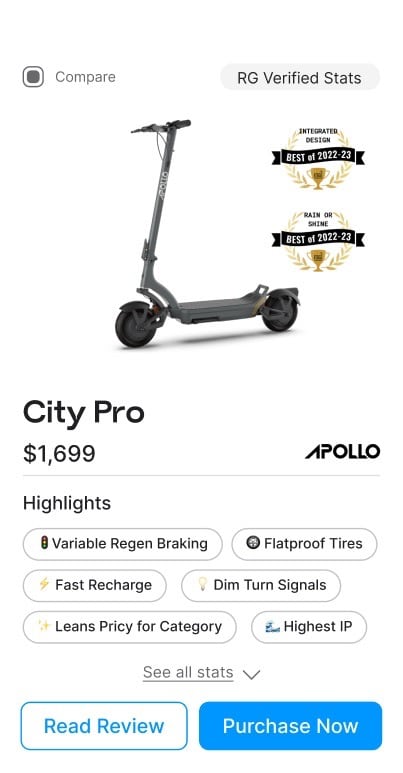
Ben Flynn
Meet Ben, your go-to scooter aficionado and in-house wordsmith at Rider Guide. With a genuine passion for two-wheelers (6 years of riding), he’s not just penning reviews but sharing firsthand experiences in an articulate narrative. You can catch him ripping through rocky trails on his Suzuki Vstrom 1000 or doing 45 miles an hour on his Dualtron Victor when he’s not busy at his writing desk, offering you the most unique and informed perspective on every scooter that rides the streets.
Explore the 10 most common mistakes beginner electric scooter riders make. Ensure a safer ride by understanding these pitfalls and learning how to avoid them
Navigating the streets on an electric scooter might seem simple at first glance, but like any mode of transportation, it comes with its own set of challenges. Especially for beginners, the allure of speed combined with ease of use can sometimes lead to an oversight of basic safety protocols and operational techniques. While electric scooters offer a convenient and eco-friendly way to get around, it’s crucial to be aware of common mistakes many new riders make.
However, we’re not limiting this article to beginners, as expert riders can also benefit from a reminder of these safety tips. As we’ve interacted with our audience online, we’re reminded that even experienced riders can become complacent and overlook important precautions, so it’s always good to refresh your knowledge and stay vigilant on the road.
By understanding the pitfalls involved with riding electric scooters, you can ensure a smoother, safer ride and extend the lifespan of your ride. Let’s delve into 10 of the most frequent mistakes beginner electric scooter riders make and learn how to avoid them. But first, the basics:
Basics to Remember When Starting on an Electric Scooter
Before getting started on an electric scooter, there are some fundamentals to be aware of. Before we get into the common mistakes riders make on an electric scooter, here are a few.
Consult the Manual: Before anything else, ensure you read and understand the user manual. This is the starting point for understanding your scooter’s functionality and safety features. It will provide you with important information on how to properly operate the scooter, including how to start and stop, how to adjust the speed, and how to handle emergency situations. Additionally, it will outline any specific maintenance requirements or recommended accessories for your scooter.
Know Your Path: Familiarize yourself with your intended route. This includes recognizing the type of terrain you’ll be riding on and being aware of potential hazards like potholes, cracks, sharp bends, and any other obstructions.
Choose the Right Scooter for Your Skill Level: If you’re a beginner, opt for a scooter tailored for new riders. Such scooters often come with gradual power surges, making them more manageable. If you’re transitioning from a basic scooter to a more advanced one, especially one with ‘P-settings,’ familiarize yourself with these settings before your first ride. Features like launch speed, cruise control, and braking can surprise you if not properly configured.
Practice in a Safe Space: Practice in a controlled environment like a parking garage before hitting the streets. This ensures you’re comfortable with the scooter’s controls and dynamics without the stress of traffic.
Fear of Falling: Falling or losing control is a natural concern for many. Instead of fearing it, educate yourself on the proper way to handle such situations. Learn how to safely land and protect yourself from severe injuries.
Speed and Safety: For new riders, remember that while going fast can be thrilling, maintaining a moderate speed is often safer and offers a more enjoyable ride as you can appreciate the environment around you. For seasoned riders, speed should never compromise safety. Just because your scooter can keep up with cars doesn’t mean you should ride recklessly on the streets. In any accident, you’re far more vulnerable on a scooter.
Always prioritize safety over speed, regardless of your expertise. Remember, riding safely ensures you can enjoy your scooter for many more rides to come.
Top 10 Riding Mistakes Riders Make and How to Avoid Them
Team Rider Guide, which includes our audience, perhaps has the most years of combined electric scooter riding expertise on the planet. Here are the top things to beware of if you’re just getting started on scooters, based on our list of common mistakes that novice riders make and your continuous input.
Setting up the Scooter
After reading the manual, you’ll be better equipped to set up your scooter. However, here is the basic checklist we use for each of our scooters.
Step One: Handlebar and Lever Adjustments
Adjust the handlebars right out of the box. Ensure the levers are neither too low nor too high. Improper alignment can cause wrist strain and impact your control, especially during sudden braking or maneuvering.
Next, set your brake levers at an angle that creates a straight line from your fingertips through your joints, wrist, and forearm. This ensures maximum comfort and effective braking. Additionally, position them in a manner that feels natural for use.
Then, secure the control clamp screws so they are firm enough to hold the controls in place but not overly tight. Controls should have some freedom to rotate upon impact to prevent breakage. At the same time, over-tightening can lead to the controls breaking, necessitating unnecessary replacements.
Step Two: Tire Pressure Checks
It’s unsafe to assume that the scooter is delivered inflated to optimum pressure, so inspect the tire pressure and inflate it to the recommended PSI. Maintaining the correct tire pressure not only ensures a smooth ride but also prevents tire wear and tear. That said, also perform regular checks as you begin to ride more. And invest in a tire gauge with a long nose, as it might come in handy for rear tires, which can be challenging to access at times.
Step Three: Front Stem Lock for Collapsible Models

If your scooter has a collapsible front stem, always double-check that the retainer is securely locked in place. This prevents any unexpected collapsing while you’re on the move.
Step Four: Maintenance
This is important for when you first receive your scooter and as common practice. Periodically inspect your scooter for any loose screws, nuts, or bolts and tighten any that seem out of place. Ignoring this can lead to parts coming off mid-ride, which is both unsafe and can damage your scooter.
The Importance of Proper Riding Stance on an Electric Scooter
Proper riding stance on an electric scooter is crucial for several reasons. However, we must first understand the ‘right’ foot position before moving on to its importance.
Choosing the Right Foot Position
There are three common types of foot placement:
- Goofy: This is when you place your right foot forward.
- Standard: This puts your left foot forward.
- Side-by-side: Both feet are parallel on the deck, which is not recommended for the reasons we’ll highlight below.
What is the 'Correct' Foot Placement?
No matter what foot position you pick, your electric scooter will move. However, the challenge comes when you factor in efficiency in control, maneuver, and safety when riding.
That said, it is advisable to adjust your foot positioning depending on the side of the road you ride. If you live in regions where driving is on the right, keep your right foot forward. This ensures that, in cases like a suddenly opened parked car door, you hit with your shoulder and not your chest, providing a safer and more agile swerving response. In left-hand-drive regions, reverse the foot placement. A good rule of thumb: Place forward the foot on the same side as parked cars relative to your direction of travel.
Weight Distribution in Relation to Riding Stance
Proper foot placement greatly contributes to effective weight distribution, which is essential for scooter control. Having one foot forward allows you to lean forward during acceleration, balance your weight during cruising, and lean back while braking. It also facilitates smoother turns, as your body can easily lean into the curve. The side-by-side stance, however, restricts efficient turning and braking due to less flexible body movement.
Maintaining Knee Flexibility
Always keep a slight bend in your knees when riding. This not only prepares you for unexpected bumps but also prevents injuries. Riding with straight, locked knees, especially on uneven surfaces, can lead to a jarring experience, and the brain massage you get can sometimes result in blurry vision—a significant hazard while navigating traffic.
Braking Technique for Electric Scooters
Without a proper braking setup or technique, there’s no safe way to bring your scooter to a halt. So, here are the basics:
Setting Up Your Brakes
Ensure your brakes are configured for easy and comfortable access, as highlighted above. Properly adjusted brakes not only provide efficient stopping power but also enhance safety during rides.
Adopting the Correct Braking Stance
- Position one foot forward.
- Bend slightly, lowering your center of gravity.
- Lean your weight towards the back.
Effective Braking Technique
Aim to reduce your scooter’s speed by applying pressure to the brakes gradually. This ensures a shorter stopping distance and more control.
And, while you want to brake firmly, avoid locking the tires completely. A locked tire can skid, decreasing your ability to steer and increasing the likelihood of toppling over the handlebars.
Remember, mastering the correct braking technique is essential for safe riding. Just as you take the time to learn acceleration and turning, understanding how to brake efficiently can be the difference between a smooth stop and a potential accident.
Navigating Different Terrain on an Electric Scooter
Before embarking on a ride, inspecting and understanding the type of terrain you’ll be navigating is crucial. Different terrains offer varied levels of traction, which can significantly impact your scooter’s stability and control.
Paul calculated the amount of traction you can get from various surfaces, taking dry pavement as the benchmark and assigning it a score of 100. Other terrain types contrasted as follows:
- Wet Pavement: 85-90
- Dry Metal: 63
- Sand: 55
- Wet Metal: 48
- Dry Leaves: 35
- Wet Leaves: 28
If you’re new to electric scooters, prioritize terrain with high traction scores. This provides better stability and reduces the likelihood of slipping or losing control. As you gain experience and build confidence, you can explore more challenging terrain.
On terrain with reduced traction, it’s essential to adjust your riding techniques. Specifically:
- Avoid Braking Abruptly: Sudden braking can lead to skidding.
- Minimize Sharp Turns: Turning sharply can cause the scooter to slide out from under you.
On the other hand, if your scooter comes equipped with dual motors, make sure to utilize them, especially on loose or challenging terrain. Dual motors provide enhanced power and stability, allowing for safer navigation on tricky surfaces.
Off-Roading on Electric Scooters
Most likely, you’ve seen videos online of people performing absurd off-road stunts on electric scooters. Here’s a warning, though, before you get too excited.
Not all scooters are built for rugged terrain, so ensure you’re using an off-road-specific scooter if you’re venturing into rough terrain. These scooters are typically designed with more robust components and thicker tires suitable for uneven ground.
That said, it’s crucial to steer clear of significant jumps or drops that exceed 1 foot. Such sudden impacts exert excessive pressure on the scooter’s components, which could compromise its structural integrity and lead to potential damages.
Again, going off-road without recognizing the scooter’s limitations can result not only in damaging the scooter but can also pose a risk to the rider. Potential falls from significant jumps or sudden breakdowns due to damaged parts can lead to life-threatening injuries.
Helmet and Gear Selection for Electric Scooter Riders
Safety gear is mandatory when riding any two-wheeled vehicle, electric scooters included. While many immediately think of helmets when considering protective gear, there’s a broader range of equipment that can enhance safety, especially for new riders.
Helmets and Helmet Types
Helmets are designed to protect the rider’s head in case of a fall or collision. There are various types of helmets available, such as:
- Bike and BMX Helmets: These are typically designed for lower-speed impacts and are generally rated to protect you in crashes up to 20 mph.
- Motorcycle Helmets: Given that electric scooters can exceed 20 mph, a motorcycle-grade helmet can offer better protection. There are two primary types:
- Open-Face Helmets: These cover the top, sides, and back of the head but leave the face exposed.
- Full-Face Helmets: These provide comprehensive protection, covering the entire head and face. At Rider Guide, we advocate for full-face helmets due to their all-around safety during crashes.
Additional Riding Gear
If you own a high-speed scooter or intend to ride fast, it’s wise to invest in complete riding gear. This can include protective jackets, gloves, knee and elbow pads, and even riding boots. Watch a comprehensive guide to our two scooter gurus, Mitchell and Paul’s, choice of riding gear.
However, if acquiring full riding gear is not immediately feasible, at a minimum, new riders should wear jeans and a long-sleeved shirt. These provide a basic level of protection against potential scrapes or road rash.
Consider investing in the right protective gear so you can enjoy your ride with the assurance that you’re adequately shielded from potential mishaps.
Cruise Control on Electric Scooters: Proceed with Caution
Cruise control, commonly advertised as a convenient feature on many electric scooters, can be a double-edged sword, especially for those new to the world of scooter riding. The appeal is undeniable: the ability to ride without constantly engaging the throttle is especially beneficial during extended rides, reducing hand fatigue.
However, many scooters don’t have clear visual or audible signals to indicate when cruise control is active. This can lead to moments of unawareness, especially if you forget you’ve enabled it. Here’s a scenario:
Imagine you’re cruising at full speed when the cruise control kicks in. As you approach an intersection, you release the throttle, expecting the scooter to slow down. But with cruise control engaged, the scooter maintains its speed, potentially leading to a dangerous situation. In such unexpected moments, panic is a natural response. While the instinct might be to abruptly brake or even jump off the scooter, both actions have risks. Sudden braking can lead to a loss of control, especially if done at high speeds. Deciding to jump off isn’t safer either; the forces of inertia mean you’ll continue moving forward at speed, leading to potential injuries from tumbling, not to mention the damage to the scooter.
Therefore, if you’re still getting the hang of riding, it’s advisable to steer clear of the cruise control feature. Only once you’re thoroughly comfortable with your scooter’s controls and have a keen awareness of its features should you consider using the cruise control function.
Always Have Both Hands on the Handlebars
One of the common habits new scooter riders carry over from bicycling is the tendency to occasionally steer with one hand. While this might feel natural, especially for those accustomed to bicycles, it’s crucial to recognize the stark differences between the two vehicles.
On a bicycle, the larger front wheel often remains straight and stable when you momentarily let go with one hand. However, this isn’t the case with electric scooters. Scooters come with smaller wheels, which are more sensitive to direction changes. Even a slight imbalance, like taking one hand off the handlebar, can lead to wheel wobble and an increased risk of tipping over.
While someone like Paul, armed with years of riding experience and thousands of dollars worth of the best protective gear, might get away with briefly steering one-handed, it’s not advisable for most riders, especially those new to scooters. The compact build and mechanics of a scooter make it more susceptible to instability when not steered with both hands.
To note: If your scooter doesn’t come equipped with turn signals and you need to indicate direction, avoid using your hand to signal as you would on a bicycle.Instead, safely use the foot corresponding to the direction you’re turning in. For instance, extend your right foot slightly to indicate a right turn. This method keeps both hands on the handlebars and maintains stability.
Night Riding on Electric Scooters
Venturing out on your electric scooter at night introduces a unique set of challenges. The limited visibility that darkness brings can pose significant risks to riders. But here’s how to ensure your safety when riding after sundown:
Enhancing Visibility
Upgrade your headlight, as the ones that come standard on many scooters often don’t shine a bright enough beam to adequately light up your path in pitch-dark conditions. Consider investing in a brighter aftermarket light to ensure you can clearly see any obstacles or hazards.
Ensuring You Are Seen
Wear Reflective Gear: While being able to see is essential, ensuring that others can see you is equally crucial. Wear clothing or vests with reflective strips, which can catch the light from car headlights or street lights, making you more visible.
Add Reflectors: If your scooter doesn’t already have them, attach reflectors on both the front and back. They’re simple additions that can significantly enhance your visibility to others.
Helmet with Light Indicators: Given the higher position of your head compared to the rest of your body, a helmet equipped with light indicators can be more noticeable to drivers than a scooter’s tail light. The blinking lights on the helmet can serve as a clear indicator of your presence on the road.
We are big fans of Okai’s hard-shell smart helmet that’s not only good-looking but also connects to the app for customization and has an integrated Bluetooth speaker.
Stay Alert
Riding at night means your surroundings are less visible, making it crucial to be extra vigilant. Look out for potential hazards, such as potholes, debris, or pedestrians. Additionally, it is essential to maintain a safe distance from other vehicles and use signals to communicate your intentions to drivers.
Navigating Wet Conditions on Electric Scooters
Riding in rainy conditions or through puddles can pose challenges not just in terms of safety but also the longevity of your electric scooter. Many of today’s scooters come with an IP (Ingress Protection) rating, indicating their level of protection against water and dust. A common rating like IPX4 suggests that the scooter can handle splashes, but it’s not designed for prolonged exposure to water.
If you will constantly ride in the rain or over puddles, it is advisable to optimize your scooter for wet conditions, and you can do this by:
Sealing Vulnerable Areas: Focus on sealing any openings or holes, especially from the deck upwards. This will prevent water from entering internal components, which could cause damage.
Mudguard Extension: A piece of rubber can serve as an extension to your existing mudguards, reducing the amount of water splashing onto you or the scooter’s essential parts and onto your feet.
Changing your Grip Tape. If your deck is covered in grip tape, switch it out once you begin to detect wear to ensure you have optimum traction.
Investing a small amount, approximately $20 at a local hardware store, in sealants and materials for these modifications can potentially save you from expensive repairs or replacements in the long run. It’s a small price to pay for the peace of mind and the extended lifespan of your scooter.
However, it is also important to remember that wet conditions can reduce traction, making it easier to skid or slip. Therefore, always reduce your speed, avoid sharp turns, and be extra cautious when braking.
Common Electric Scooter Riding Mistakes and Their Solutions : Conclusion

Riding an electric scooter is an exciting experience that provides convenience, eco-friendliness, and a touch of modernity to our daily commute. However, like all modes of transport, it requires attention to safety, awareness of its functionality, and respect for the environment in which you ride.
From understanding the basics to mastering advanced techniques and navigation across various terrains, this comprehensive guide has aimed to equip both novice and seasoned riders with essential knowledge. A key takeaway is that safety should always be paramount, whether it’s through proper gear, understanding your scooter’s features, or being vigilant in different riding conditions.
The beauty of the electric scooter lies in its simplicity, but never should this simplicity lead to complacency. By continuously educating ourselves and adopting safe riding habits, we can ensure that every ride is both enjoyable and safe. Remember, a well-informed rider is a safe rider. Safe travels!







